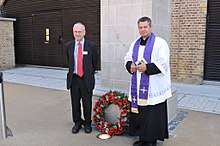Hoxton railway station
| Hoxton | |
|---|---|
 West facade and the southern end of Geffrye Street in July 2016 | |
| Location | Hoxton |
| Local authority | London Borough of Hackney |
| Managed by | London Overground |
| Owner | Transport for London |
| Station code(s) | HOX |
| Number of platforms | 2 |
| Accessible | Yes |
| Fare zone | 1and2 |
| National Rail annual entry and exit | |
| 2018–19 | |
| 2019–20 | |
| 2020–21 | |
| 2021–22 | |
| 2022–23 | |
| Key dates | |
| 27 April 2010 | Opened[2] |
| Other information | |
| External links | |
| Coordinates | 51°31′54″N0°04′31″W/ 51.5318°N 0.0754°W |
Hoxtonis astationon theEast London linein theLondon Borough of Hackney,Greater London.It is on theKingsland Viaductand served byLondon Overground.The station entrance is on Geffrye Street near Dunloe Street and Cremer Street, behind theMuseum of the Home.[3]
The station was officially opened on 27 April 2010, initially with week-day services running betweenDalston JunctionandNew CrossorNew Cross Gate.On 23 May 2010 services were extended from New Cross Gate toWest CroydonorCrystal Palace.[4]
History
[edit]
Hoxton station was first identified as a new station in aLondon Undergroundproposal made in 1993 to extend the line fromWhitechapelto Dalston Junction, involving the construction of new stations atBishopsgate(Later opened asShoreditch High Street), Hoxton andHaggerston,[5][6]and received the support of a public inquiry in 1994. It was envisaged that the construction of the extension and the station itself would begin in 1996 and to be completed by 1998. The project was finally approved by the Government in 1996[7]but a lack of funding forced the project to be delayed in 1997.[8]
The station is currently the only completely new station to be built along the route of the former Broad Street branch of theNorth London lineunder the East London line project, although it is located on the tracks leading to the former Shoreditch (Dunloe Street) Depot, which was closed in 1968.[9]
At ground level at the entrance to the station is theFirst World War memorialcommemorating fallen staff of the formerNorth London Railway,which built the section of viaduct that is now the modern East London Line through Hoxton.[10]Originally placed at now-closed Broad Street Station, it was moved to first Richmond and then in 2011 returned to be nearer its former location.[11]It is listed with Grade II.[12][13]
Layout
[edit]Hoxton station is a standard two-platform station with platforms situated on the Kingsland Viaduct. The platforms were originally built to accommodate a train of up to four cars but in 2015 the platforms were extended to accommodate five car electric trains of classes Class 378/1 (third rail shoes only) and 378/2 (third rail shoes and pantograph). The Ticket office and entrance concourse is located under the viaduct and access to each platform is provided by a lift and stairs.[14]
Services and connections
[edit]
All times below are correct as of the December 2010 timetables.
Mondays to Saturdays there is a service every 5–10 minutes throughout the day, while on Sundays before 13:00 there is a service every 5–9 minutes, changing to every 7–8 minutes until the end of service after that.[15]Current off peak frequency in trains per hour is:
- 16 tph toDalston Junction,of which 8 continue toHighbury & Islington
- 4 tph toCrystal Palace
- 4 tph toNew Cross
- 4 tph toWest Croydon
- 4 tph toClapham JunctionviaPeckham Rye
London Busesroutes26,55,149,242,243,394and night routesN26,N55andN242serve the station.[16][17]
References
[edit]- ^abcde"Estimates of station usage".Rail statistics.Office of Rail Regulation.Please note: Some methodology may vary year on year.
- ^BBC London:The new East London Line opens to the public.Retrieved 27 April 2010
- ^"Station Information for Hoxton".National Rail.2010.Retrieved9 April2010.
- ^"London Overground - Dalston Junction to West Croydon".Projects and Schemes.Transport for London.Retrieved14 May2010.
- ^"Moves to extend East London Line."Building,14 May 1993
- ^"East London Line - London Underground to seek consent."Estates Gazette,4 December 1993
- ^"Final approval given for powers to construct East London Line northern extension." Department of Transport, 16 January 1997
- ^"Where Tube axe falls."The Times,21 February 1997
- ^Brown, Joe (2009).London Railway Atlas(2nd ed.).Ian Allan Publishing.p. 23.ISBN978-0-7110-3397-9.
- ^"North London Railway War Memorial".Imperial War Museum.Retrieved26 September2017.
- ^"The Return of the Broad Street War Memorial".London Reconnections.16 September 2011.Retrieved26 September2017.
- ^Historic England."North London Railwaymen War Memorial (1445194)".National Heritage List for England.Retrieved26 September2017.
- ^Bloomfield, Peter."NLR War Memorial".Railwaymen NLR.Retrieved26 September2017.
- ^"Hoxton Plan".National Rail Enquiries. Archived fromthe originalon 5 June 2011.Retrieved16 June2010.
- ^"Archived copy"(PDF).Archived fromthe original(PDF)on 8 April 2011.Retrieved28 February2011.
{{cite web}}:CS1 maint: archived copy as title (link) - ^"Hoxton Station".TfL.Retrieved17 May2020.
- ^"Hoxton Station / Geffrye Museum".TfL.Retrieved17 May2020.
External links
[edit]| Preceding station | Following station | |||
|---|---|---|---|---|
| Haggerston towardsHighbury & IslingtonorDalston Junction
|
East London line | Shoreditch High Street | ||
- Rail transport stations in London fare zone 1
- Rail transport stations in London fare zone 2
- Railway stations in the London Borough of Hackney
- Railway stations opened by Network Rail
- Railway stations in Great Britain opened in 2010
- Railway stations served by London Overground
- London Overground Night Overground stations
- Hoxton

